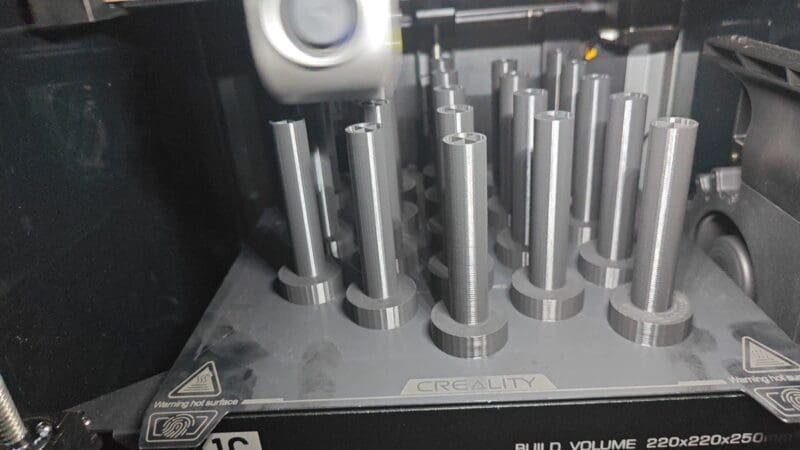Bambu Lab X1 Carbon Review: Worth It or Not?

Introduction
3D printing technology has reached a high level of maturity. Entry-level FDM 3D printers can now be purchased for as low as $200, but unlike other products, 3D printers are still quite challenging for consumers unfamiliar with them. From selecting materials to configuring printer parameters and even different slicing software, these factors can impact the printing outcome. A deeper understanding reveals that 3D printing success depends largely on hardware and fine-tuning.
In May 2022, a Kickstarter crowdfunding project gained significant attention. Within just a month, the project attracted over 5,500 backers. Their product? Bambu Lab X1 Carbon series 3D printer, is believed to potentially revolutionize the consumer-grade 3D printer market. I’ve had this printer for a while now and have used it to print various models. It’s incredibly user-friendly, requiring no preparation work and experiencing minimal printing failures. Today, we’ll primarily evaluate the Bambu Lab X1 Carbon’s hardware, software, and printing tests to provide a comprehensive understanding of this machine. Discover the future of 3D printing with our in-depth Bambu Lab X1 Carbon review.

Hardware and Functional Design
Aesthetic Design

As the saying goes, appearances matter. The X1C features an aluminum alloy side and back panel, a sleek black glass top cover, and a chamber door, exuding a strong sense of technology and industrial design. Except for a 5-inch touchscreen attached via cables, all components are concealed within the printer’s body. The chamber door and side panel showcase the all-metal frame, proudly constructed with robot-automated welding technology, ensuring high strength and precision.

Architecture

Bambu Lab X1 Carbon utilizes a non-traditional CoreXY architecture. The X-axis employs lightweight carbon fiber, while the Z-axis features a three-lead screw design driven by a stepper motor through a synchronous belt. This design ensures permanent synchronization of the 3 Z-axes. However, it lacks the ability to independently calibrate the C-axis, demanding high precision during installation and design.

Print Head

What sets the X1C apart is its integrated micro-laser radar and micro-vision recognition camera within the print head. Unlike traditional 3D printers requiring manual flow calibration and vibration compensation, the X1C automates these processes. While lasers, vision recognition, and AI algorithms are not groundbreaking technologies, applying them to 3D printing places Bambu Lab ahead of the curve. The print head’s high integration features two PCBs connected to the mainboard through a single integrated cable. The magnetic print head cover even incorporates sensors to ensure proper installation.
Extruders and Extrusion System

The extruders and extrusion mechanism are customized, unlike traditional 3D printers. The X1C’s nozzle and cooling components are pre-assembled, making nozzle replacement convenient though costly. However, the benefits outweigh the cost, given the ease of replacement.
Cutting Mechanism

A cutting mechanism is attached to the side of the print head. When changing filament, it first cuts off the material to prevent blockages during retraction.
Heated Bed


The printer’s heated bed maintains even heating, with the print bed secured magnetically. The provided print bed has printing instructions for various materials printed directly on it to prevent user error. Additionally, a camera beneath the print head scans the bed’s identification code to warn users of incorrect installation. The bed incorporates three pressure sensors for multi-point mesh calibration based on nozzle contact.

Camera

A 1080P camera on the front-left corner serves for monitoring, time-lapse photography, and AI detection. Upon detecting print errors, it pauses the print and sends a notification via the mobile app. During printing of materials like PLA requiring cooling, auxiliary fans activate. All fans in the X1C are closed-loop controlled, allowing precise adjustment of airflow by regulating speed. Numerous sensors within the compact body include one on the chamber door for detection.
AMS Automatic Filament System

An industry-disrupting feature is the AMS automatic filament system. While automatic filament change and multi-color printing have been around, they were complex to configure and DIY, requiring constant monitoring to avoid failure. Bambu Lab’s AMS truly brings automation and productization to these concepts.

Installation is straightforward, with two wire harnesses connecting AMS to the buffer and printer. Through the Hub, up to four AMS units can be connected, enabling 16-material automatic filament exchange. The hub, an additional purchase, allows AMS recognition without any manual setup. AMS also features material detection and automated purging, achieving one of the most convenient purging functions. Bambu Lab redesigned filament spools with RFID for automatic material recognition. Third-party filaments can also be configured manually, and material usage can be estimated through spool rotation and filament length. The reusable tray adds an environmentally friendly touch.
Proprietary Filaments

Bambu Lab also develops high-quality filaments, such as PAHTCF and PLACF. PAHTCF boasts lower water absorption and better mechanical performance for durable engineering applications. PLACF offers a smoother surface finish and improved mechanical properties compared to standard PLA while maintaining ease of use.
AMS: Automatic Material Switching

The most intriguing aspect of AMS is its material switch gearbox. Ingeniously, a single motor drives a swinging planetary gear, enabling material purging and retraction. When combined with AMS, X1C doesn’t rely on direct extruder action for filament exchange. Instead, AMS auto-loads a small section of filament into the buffer, which is then fed into the extruder when needed. This design ensures reliable material exchange. AMS, buffer, and the print head’s cutter form a stable automatic material switching system.

Software
Proprietary Firmware
While traditional 3D printers mostly use open-source Marlin or Klipper firmware, Bambu Lab developed its proprietary firmware, creating a seamless interaction between software and hardware. The firmware harnesses over 40 sensors within the printer for automatic operation, eliminating the need for user adjustments. Firmware updates bring bug fixes and new features, which traditional printer manufacturers struggle to achieve.
Slicing Software

Bambu Lab’s slicing software is based on a customized version of SuperSlicer. It provides high compatibility, offering preset parameters for Bambu Lab machines and print beds, with automatic material synchronization from AMS. Each filament type has preset parameters, making it beginner-friendly with minimal adjustments required.
The software allows you to choose the material for slicing; AMS will automatically switch materials during printing. The software also enables printer status monitoring and control. Bambu Lab Studio supports the 3MF file format, allowing multiple print beds to be added and saved, streamlining future printing of similar projects. The platform goes beyond slicer functionality, enabling project management by adding descriptions, images, tables, and assembly manuals.
Printing Tests

I printed test models using the slicer’s preset parameters. Let’s first examine a small boat. The X1C’s printing speed has garnered considerable attention. Indeed, I was astounded by its speed when I first began printing. It completed the boat in just over 20 minutes. The print quality is impressive, rivaling the quality of prints from my Voron, which takes over an hour for similar prints.

A larger model, like the mechanical Godzilla, took over 70 hours to print. Traditional printers might take a week to complete such a project. The quality is commendable, with clear textures, even lines, and excellent joint assembly. Some minor rippling might appear due to high-speed printing, but it’s acceptable.

Multiple-color printing presents another achievement. This 4-color model took even longer, around 25 hours. Nevertheless, the result is satisfactory, without visible color mixing or layer inconsistencies. AMS’s usefulness extends beyond multi-color printing to composite printing with multiple materials. For example, embedding transparent PETG within ABS to achieve translucency is possible, allowing for multi-material prints without material change, a practical advantage.

Drawbacks
However, every coin has two sides. X1C’s flaws are noticeable, with noise being the most prominent. During full-speed printing, the noise is considerable, even audible through walls in a quiet room. Four main sources contribute to this noise:
- Motor noise during high-speed printing. Traditional 3D printers employ TMC series drivers with StallGuard technology to reduce noise. X1C uses MOSFETs to directly drive motors, resulting in higher noise levels.
- The combination of carbon fiber and linear rods in the X-axis and the optical axis in the Y-axis generates noise at high speeds.
- To achieve super-fast printing, Bambu Lab added a high-speed auxiliary cooling fan, contributing to the noise.
- The metal-on-metal impact during the print head’s material wiping adds to the noise.
Full-speed printing at night is not advisable due to the noise. The AMS’s material change precision needs improvement. Without end-detection sensors, it can’t halt when intermediate material is depleted, often leading to partial changes. Achieving accurate AMS material swaps requires experience and isn’t as simple as changing filament manually.
Apart from noise, X1C’s performance on certain details at high speeds falls short of expectations. Despite its advanced print head, equipped with lasers and other technologies, it remains limited by speed. Fine details, such as textures and small curves, might not be as precise. This trade-off between speed and precision is expected. Achieving exceptional print quality might require slowing down. Nevertheless, X1C performs remarkably well overall, especially for large prints.
X1C struggles with overhang support, especially for models with suspended sections. The existing support structures might not always provide sufficient support for overhangs. Manual adjustments or exploring other printers might be necessary for models requiring complex overhangs.
Bambu Lab X1 Carbon: Conclusion
In conclusion, the Bambu Lab X1C series 3D printer is undoubtedly an outstanding consumer-grade printer. Its speed, automatic filament system, and AI features set industry standards. Print quality is impressive, particularly for larger prints. However, the printer has some drawbacks, including noise, precision in automatic filament change, and overhang support. If you value efficiency and convenience, you’ll appreciate this printer. Even if you prioritize print quality and precision, you won’t be disappointed. The Bambu Lab X1C series 3D printer is highly recommended. If you have a limited budget, the Bambulab P1P might be a better choice.
Remember, every 3D printer has its unique characteristics and best-use scenarios. Your final choice should align with your requirements and budget. I hope this information proves useful, and I wish you an enjoyable journey in the world of 3D printing!
DISCLOSURE: THIS POST MAY CONTAIN AFFILIATE LINKS, MEANING I GET A COMMISSION IF you DECIDE TO MAKE A PURCHASE THROUGH MY LINKS, AT NO COST TO YOU. PLEASE READ MY DISCLOSURE FOR MORE INFO.



